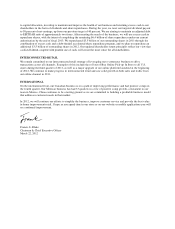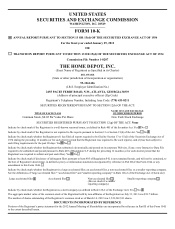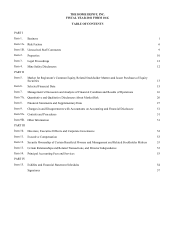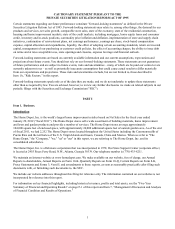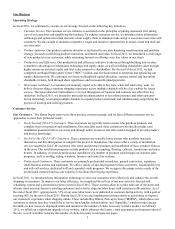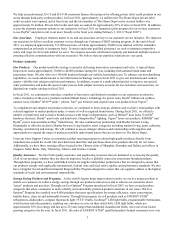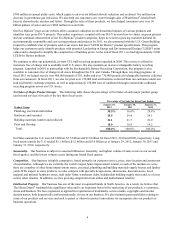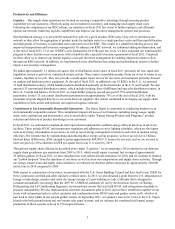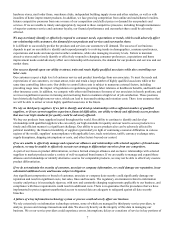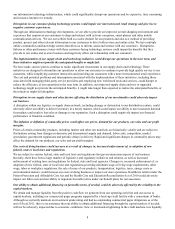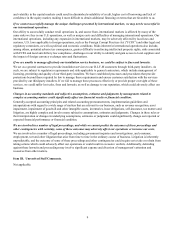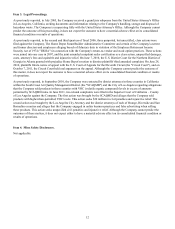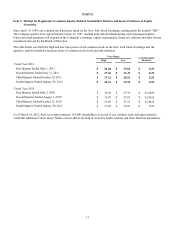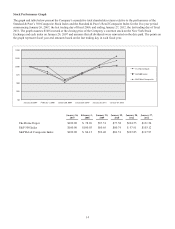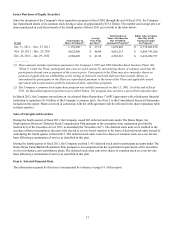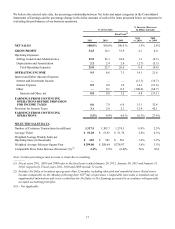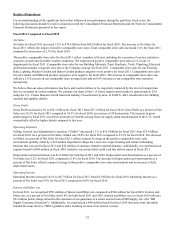Home Depot 2011 Annual Report Download - page 14
Download and view the complete annual report
Please find page 14 of the 2011 Home Depot annual report below. You can navigate through the pages in the report by either clicking on the pages listed below, or by using the keyword search tool below to find specific information within the annual report.
8
our information technology infrastructure, which could significantly disrupt our operations and be expensive, time consuming
and resource-intensive to remedy.
Disruptions in our customer-facing technology systems could impair our interconnected retail strategy and give rise to
negative customer experiences.
Through our information technology developments, we are able to provide an improved overall shopping environment and
experience that empowers our customers to shop and interact with us from computers, smart phones and other mobile
communication devices. We use our website both as a sales channel for our products and also as a method of providing
product, project and other relevant information to our customers to drive both in-store and online sales. We have multiple
online communities and knowledge centers that allow us to inform, assist and interact with our customers. Disruptions,
failures or other performance issues with these customer-facing technology systems could impair the benefits that they
provide to our online and in-store business and negatively affect our relationship with our customers.
The implementation of our supply chain and technology initiatives could disrupt our operations in the near term, and
these initiatives might not provide the anticipated benefits or might fail.
We have made, and we plan to continue to make, significant investments in our supply chain and technology. These
initiatives are designed to streamline our operations to allow our associates to continue to provide high quality service to our
customers, while simplifying customer interaction and providing our customers with a more interconnected retail experience.
The cost and potential problems and interruptions associated with the implementation of these initiatives, including those
associated with managing third-party service providers and employing new web-based tools and services, could disrupt or
reduce the efficiency of our operations in the near term. In addition, our improved supply chain and new or upgraded
technology might not provide the anticipated benefits, it might take longer than expected to realize the anticipated benefits, or
the initiatives might fail altogether.
Disruptions in our supply chain and other factors affecting the distribution of our merchandise could adversely impact
our business.
A disruption within our logistics or supply chain network, including damage or destruction to our distribution centers, could
adversely affect our ability to deliver inventory in a timely manner, which could impair our ability to meet customer demand
for products and result in lost sales or damage to our reputation. Such a disruption could negatively impact our financial
performance or financial condition.
The inflation or deflation of commodity prices could affect our prices, demand for our products, our sales and our profit
margins.
Prices of certain commodity products, including lumber and other raw materials, are historically volatile and are subject to
fluctuations arising from changes in domestic and international supply and demand, labor costs, competition, market
speculation, government regulations and periodic delays in delivery. Rapid and significant changes in commodity prices may
affect the demand for our products, our sales and our profit margins.
Our costs of doing business could increase as a result of changes in, increased enforcement of, or adoption of new
federal, state or local laws and regulations.
We are subject to various federal, state and local laws and regulations that govern numerous aspects of our business.
Recently, there have been a large number of legislative and regulatory initiatives and reforms, as well as increased
enforcement of existing laws and regulations by federal, state and local agencies. Changes in, increased enforcement of, or
adoption of new federal, state or local laws and regulations governing minimum wage or living wage requirements, other
wage, labor or workplace regulations, the sale of some of our products, transportation, logistics, taxes, energy costs or
environmental matters, could increase our costs of doing business or impact our store operations. Healthcare reform under the
Patient Protection and Affordable Care Act and the Health Care and Education Reconciliation Act of 2010 could adversely
impact our labor costs and our ability to negotiate favorable terms under our benefit plans for our associates.
Our ability to obtain additional financing on favorable terms, if needed, could be adversely affected by the volatility in the
capital markets.
We obtain and manage liquidity from the positive cash flow we generate from our operating activities and our access to
capital markets, including our commercial paper programs supported by a back-up credit facility with a consortium of banks.
Although we currently maintain an investment grade rating and had no outstanding commercial paper obligations as of the
end of fiscal 2011, there is no assurance that our ability to obtain additional financing through the capital markets, if needed,
will not be adversely impacted due to economic conditions. New or incremental tightening in the credit markets, low liquidity


